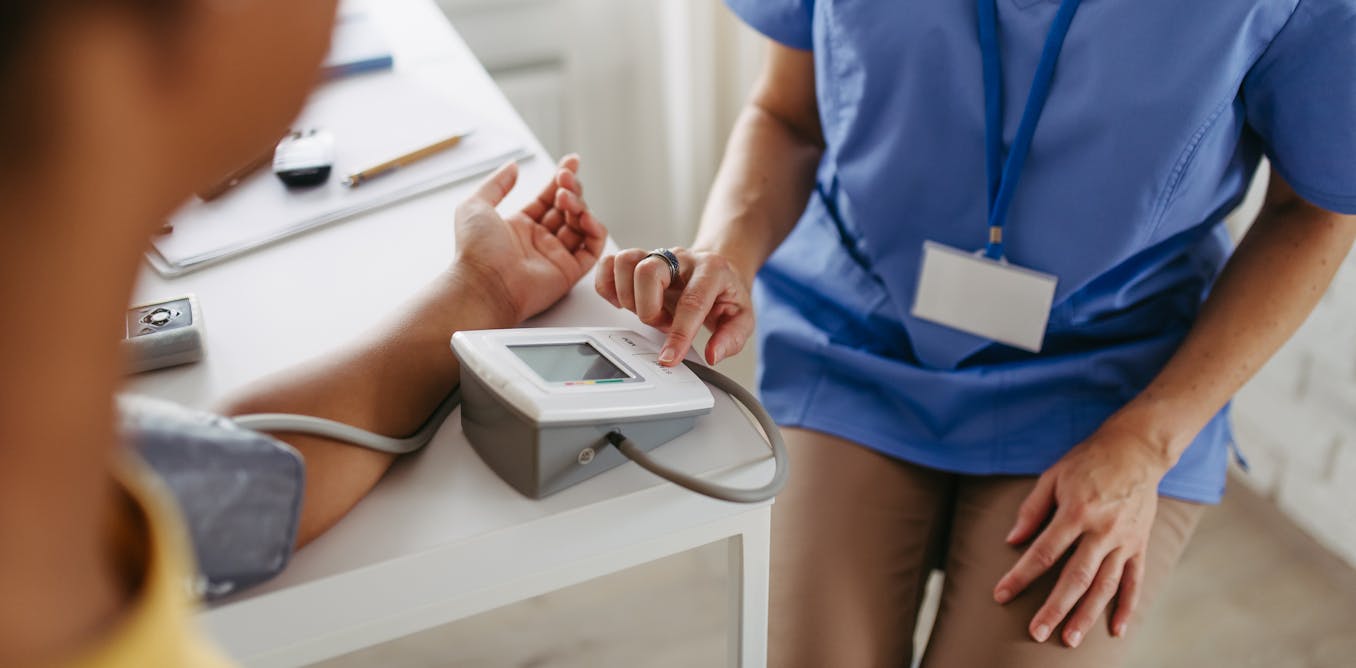CARRYING shopping while walking up stairs and chopping wood – the former I do all the time but the latter is very rare.
Yet both are among nine movements that we should all be able to do at age 50 in order to stay fit until 90.
10

10
That is according to Will Harlow, physiotherapist, over-fifties health specialist and author of new book, Thriving Beyond Fifty.
Given my 50th is in January, I decided to see how I fared.
After all, there is a higher chance than ever that I could live to 90, according to the Office for National Statistics.
A recent report finds there are 551,758 people aged over 90 in England and Wales — a 0.2 per cent increase from 2022, compared with a 2.1 per cent rise in the previous year.
I’m very conscious of my health and do everything I can to stay as fit and healthy as possible.
I don’t drink or smoke, I try to exercise every day, whether it be a walk, yoga, swimming or weights, and I eat healthily.
I’ve lost more than two stone this year, after realising the weight was piling on and that this can have health implications.
Both of my parents died at age 55, — Mum from cancer and Dad from MND, ten years apart.
As I now approach that milestone of turning 50, I’ve become more aware of my own mortality.
Will says: “There is still so much living to do after the 50-year mark. I like to think of 50 as the halfway point in life. Living to 100 years old may seem far-fetched but getting there is becoming more realistic with each passing decade.
“The problem is that many people may live to a wonderful age in numerical terms, yet their later years are plagued by pain and suffering.
“This can turn those final decades of your life from being potentially the most rewarding to instead the most cruel.”
But it doesn’t have to be that way. With a bit of investment, your older years can be pain-free and healthy.
Will explains: “The Nine at 90 is a collection of movements that can be used to effectively screen your whole body for movement problems.
Screen whole body
“Many people are surprised to discover they are unable to do some of these movements, and I would not expect every older person to be able to do them.
“But they simply reveal where your problem areas might be, and that realisation can give you a clear objective to work towards.”
Here, we explain nine tasks you should be able to do at 50 to keep yourself fit.
Give them a go . . .
- Thriving Beyond Fifty: 111 Natural Strategies to Restore Your Mobility, Avoid Surgery and Stay Off Pain Pills For Good, by Will Harlow (Hay House, £19.99) is out now
Do these at 50 – to stay fit at 90
THE FLOOR GET-UP
THE consequences of falls cost the NHS over £2billion per year.
The perils of suffering a fall are enormous.
They are the most common cause of injury-related deaths for over-75s, according to Age UK.
Will says: “Luckily, for many people falls don’t damage anything more than their confidence.
“But having fallen, there is another problem you must face.
“That problem is how to get up from the floor, especially when no one else is around.”
This isn’t the way that I would usually attempt to get up from the floor, but I imagine it is a good one to practise as you get older.
TO DO:
- Begin by lying flat on the floor. Bend your right knee so that your right foot is flat on the floor, then swing your right leg over your left leg, using the momentum to turn on to your left side.
- Using your arms for stability, continue turning your body, bending your left knee as you do so, until you are in a kneeling position.
- Continue to bring the leg through and place the foot on the floor, then rise so you are kneeling on one knee.
- Move your right leg forward and place your right foot on the floor, then push back with your hands to slowly straighten into a standing position.
THE SUITCASE LIFT
APPARENTLY, being able to put your cabin suitcase into the overhead luggage compartment on a plane requires considerable upper-body strength, and stability.
Will says: “The shoulders, arms and ‘core’ muscles are all highly active when we lift and shift above our heads, and excellent shoulder mobility is also required when it comes to reaching for your case.”

10

10
This task wasn’t too bad but I can see how it would be a challenge if somebody has particularly tight shoulders.
TO DO:
- Lift a suitcase up from the floor and rest it against the front of your legs, then use the strength in your arms and shoulders to bring the suitcase to chest height.
- Keeping your buttocks squeezed tightly to protect your back, extend your arms and lift the suitcase overhead.
THE BOX LIFT
PICKING up a light object like a sock, phone or cable is something most of us can do in a swift movement.
But Will says: “When we come across a heavy load on the floor that needs shifting, it’s important we have the ability to do this without risk of injury.

10
“For this movement, ankle and hip mobility are vital, as well as strength and coordination of the lower-limb muscles.”
I can be guilty of not getting down properly to pick things up, so will remind myself this is the best way to do it.
It wasn’t too hard – but ask me when I try to shift some-thing particularly heavy.
TO DO:
- Keeping a straight back, bend at the hips and knees to bring your hands low enough so that they can get underneath the object.
- Pushing up through your feet, extend the hips and knees while maintaining a straight back, and stand up with the object in your arms.
THE STAIR CLIMB WITH LOAD
I FEEL like I spend my life taking stuff up and down the stairs – washing, plates and bags.
Will says: “It’s important to be able to climb the stairs without the use of the handrail when one isn’t available, and to be able to transport a heavy load in each hand up and down the staircase when required.

10
“Climbing the stairs with a bag of shopping in each hand is a great test for your leg strength and overall stability.
“If you can do this task, it should bring you confidence across the board.”
I’m well-practised at this but always make sure I walk slowly, as I am conscious of tripping.
TO DO:
- Hold a bag of shopping in each hand, ensuring that the weight is evenly distributed.
- As you walk up the stairs, keep your back straight and tummy pulled in. Focus on something in the distance if you need a bit of extra help with balance.
DUMBELL ON A CHAIR
THIS was pretty easy and it’s something I try to do frequently.
But the added weight did make it harder.

10

10
Will says: “Being able to sit down and stand up with good control throughout this motion, without using your hands, shows excellent control of your thigh muscles – one of the key muscle groups for many of the tasks we perform every day.
“I use this movement as my number one quick screening tool when I have a client with a lower-limb problem, to check how well they’re moving before we get to work.”
TO DO:
- Hold a small weight (or two or three books) in front of your body, close to your chest. Stand with the backs of your legs in contact with the seat.
- Bending at the hips and the knees but keeping a straight spine, slowly (to the count of four seconds) lower yourself on to the chair. Avoid “dropping” down on to the seat at the final moment.
THE HOLE-DIG
CHANCES are this isn’t something you need to do regularly, but digging is a great form of exercise.
Will says: “Digging with a heavy spade is an activity that involves a range of muscle groups, meaning the benefits of this activity are widespread.
“Not only will each thrust of the spade require a maximal effort from your muscles, but the effort will require your heart and lungs to be working well, too.
“Because of this, being able to dig a hole represents the ability to perform a truly practical, physical activity that transfers across many other DIY or garden tasks.”
This was a challenge for me, from a cardiovascular point of view. I was pretty hot after a few minutes – it’s a really good workout.
TO DO:
- Hold a spade in two hands and dig using the power of your legs, not your back.
- Dig steadily, making sure you get out breath to really make this a workout.
THE GARDENING CROUCH
MANY older people could only dream of getting this close to the floor but you may be used to the gardening crouch if you’re green-fingered.
Will says: “It requires excellent mobility of your ankles, knees and hip.

10
“The common substitute people make for this movement is to ‘fold’ at the waist and use the movement of their lower back to reach for the floor.
“Constant repetitive use of this action can lead to back pain and isn’t good for your long-term back health.”
I squat most days to lift things from the floor so don’t find this difficult.
TO DO:
- Crouch down as low as possible, keeping your back flat, and turn your feet out slightly to protect your knees. Ideally, your feet should be flat on the floor.
- If necessary, support your heels with a folded blanket.
THE WOOD CHOP
WILL says: “Swinging the axe requires you to generate force with your lower limbs, then transfer it up through your trunk to your arms before contracting your shoulders and trunk to bring the axe down.
“Almost every muscle group in the body is used.”
It was hard work and my heart was racing after just a few chops.
My core needs to be stronger to protect my back.
TO DO:
- Take the axe above your head and bring it down slowly to the lump of wood.
- Repeat this exercise over and again, until the wood is chopped.
THE FIVE-MILE WALK
I TRY to walk at least 8,000 steps a day, which is about three to four miles, but will push myself to add more moving forward.
Will reckons walking five miles is a “good audit of your general mobility”.

10
He says: “Little niggles and problems with your walking technique are likely to show, highlighting areas of your body that need extra work.
“What’s more, having the ability to walk five miles gives you confidence in certain situations that, luckily, we don’t have to contend with very often but are always a possibility – such as being stranded some-where after your car has broken down, with no signal to call the breakdown services.”
TO DO:
- Five miles is about 10,000 steps a day and can be taken in either one go, or shorter amounts throughout the day.
HOW DID YOU FARE?
WILL says: “If you can’t complete the tasks in the Nine at Ninety, don’t worry: it’s likely that you’re just out of practice.
“When we don’t use these parts of our body regularly, we lose the ability to call on them when we need to.
“But, in many cases, this process is reversible.
“There are many goals that are closer to being within reach than you think.
“First, you need to work out if the reason you can’t perform these movements is because of lack of practice, or because an injury is preventing you from doing so.
“Get the injury problem solved first before trying to push on with these tasks.
“Seek out some professional advice about your individual circumstances.
“If you think that most of these are within your capabilities at this current time, that’s fantastic and should be applauded.
“Your task is simply to maintain your ability to perform these movements as each year passes, watching out for early signs of stiffness or weakness that may prohibit your movement.
“Key ‘sticky’ areas to watch for are loss of movement in your shoulder joints, tightness in your calves and stiffness in the hips and knees.
“Keep an eye on these areas and seek guidance if you feel stiffness or tightness setting in any time soon.”




